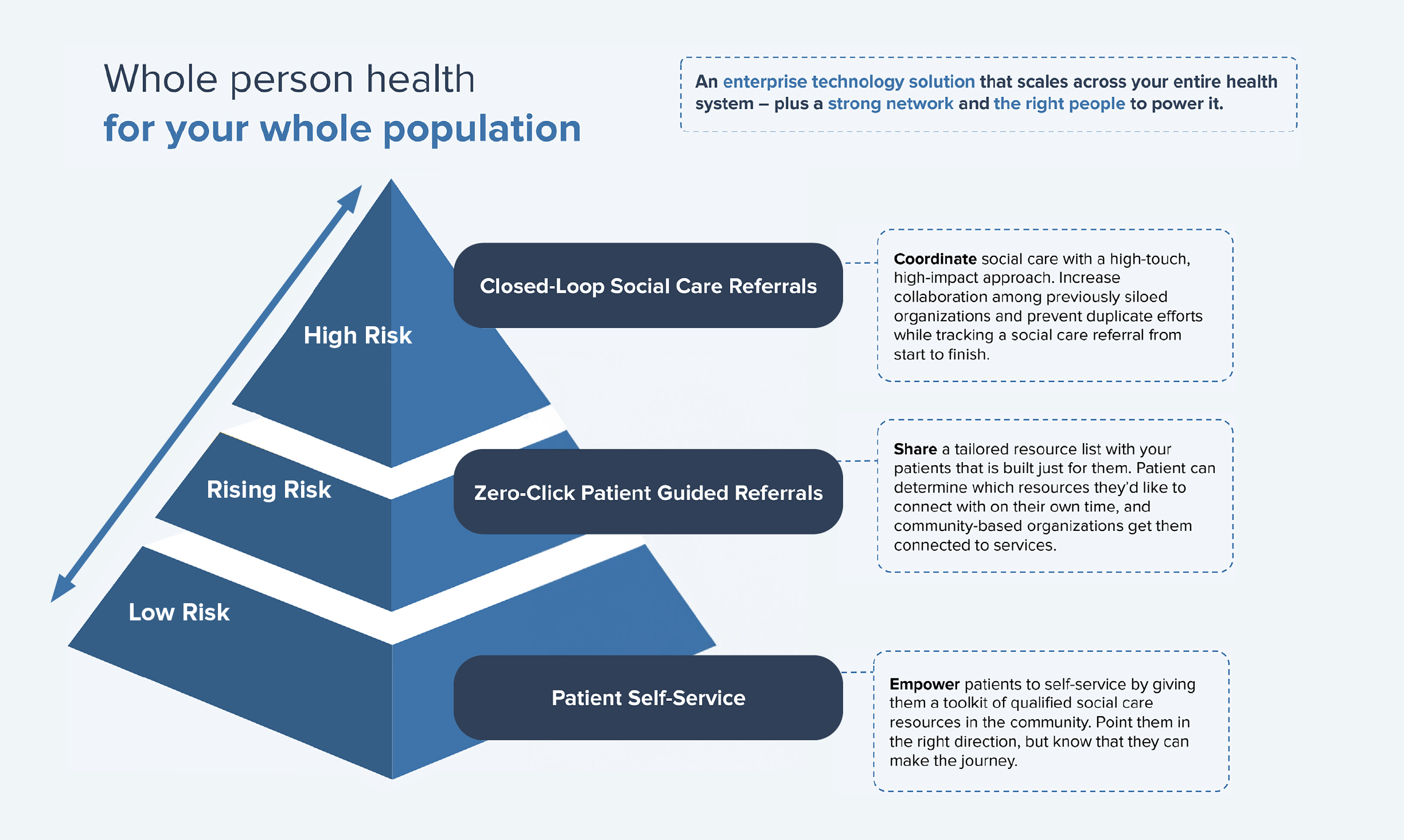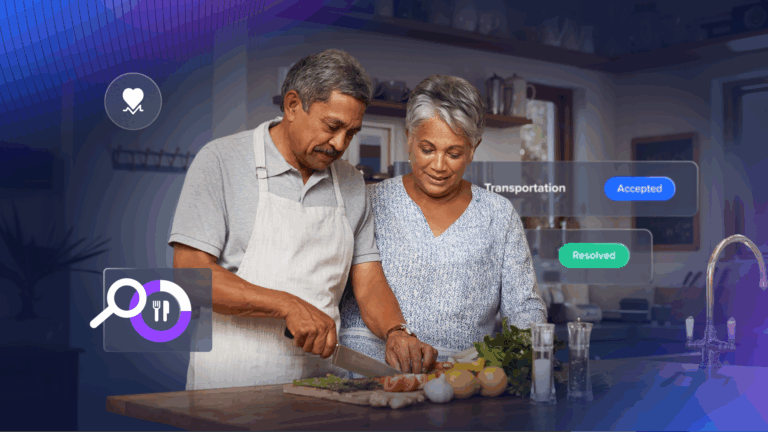
Whole Person Health for Your Whole Population: How Providers Can Support Patients’ Social Care Needs at Scale
Unite Us recently published a report in partnership with Fierce Healthcare exploring the role whole-person care plays in transforming healthcare delivery, enhancing patient outcomes, and reducing healthcare costs. As whole-person care models continue to drive the future of healthcare delivery, the report explores five tips and recommendations for providers to address SDoH and improve patient outcomes—without adding administrative burden.
Introduction
Imagine this: A patient enters your health system presenting with flu symptoms. Through the course of conversation, the physician identifies that the patient may not have enough
food at home.
Does your health system have a clear workflow in place for what to do next that makes the most of the physician’s time and also gets the patient the resources they need to thrive?
Healthcare, education, social and community engagement, economic stability, and physical environment — these powerful factors can influence whether or not a patient will require additional care or be able to avoid a future visit to the emergency room.
It’s crucial hospital systems equip care teams with information and technology-enabled workflows that allow them to refer patients to community resources in a streamlined, scalable way.
Support Healthcare Providers in Providing Personalized Care
Healthcare isn’t a one-size-fits-all approach, and neither is social care. Providers need to be able to offer different approaches and recommendations when supporting patients based on what makes the most sense for the care team and the individual being served. But they can’t be alone in offering this support — they need to be enabled at the care team and hospital level in a way that fits with how they already work.

“I enjoy having the shared accountability between the sender and receiver of resource referrals. This can only benefit our patients.”
Nicholas King, MSW, Sarasota Memorial Health Care System
Providers need to be able to quickly access, select, and share resources appropriate to the situation without leaving their EHR. Interoperable screening and referral platforms like Unite Us make it possible to address social care needs within the EHR so physicians and case managers aren’t doing duplicate data entry to get patients the information they need. “Right now, new regulations are requiring providers to screen for social needs, but in the future, we’re anticipating that providers will also need to play an active role in addressing those social needs–including the ability to demonstrate referral outcomes,” says Payton Shephard, Sales Executive, Unite Us.
Equip Healthcare Providers With Automated and Integrated Workflows
Adding manual to-dos to already strapped care teams results in confusion and overwhelm. Any process that requires physicians to leave the EHR to coordinate more care adds time, stress, and potential error to the physician’s workflow. Care teams need to be able to leverage automation to streamline processes and increase efficiency so they can keep their focus on the patients, not on the paperwork.
Technology solutions like Unite Us help care teams take the next step after identifying the social care needs a patient might have without adding additional time, effort, or documentation. The end result is that care teams are able to empower the patient with information and resources and give them clear next steps — without leaving the EHR.
“The future of healthcare will encompass technology-enabled workflows,” says Hancock. “As they are often the first point of contact for a patient, health systems and physicians can do a lot of good by acknowledging their role in the larger ecosystem of care and being a part of referring patients to much-needed resources. It shouldn’t, however, require additional time or effort on their part. And that’s where technology solutions like Unite Us can help.”
Sarasota Memorial Health Care System’s experience improving care outcomes and lowering costs with Unite Us.
Preliminary results of the study included:
- 70% reduction in odds of all-cause readmissions and a 79% reduction
in the odds of postpartum-related readmissions for Medicaid enrollees - Over $350,000 estimated savings for all-cause readmissions per
1,000 deliveries - Continued reduction in odds of hospital admission up to 12 months
after delivery
Give Healthcare Providers Access to the Outcomes Data They Need
Having clear, accurate data about referral outcomes is top-of-mind for healthcare leaders. When referring patients to social care resources, care teams need to be able to dive deep into the data to understand what’s working, what’s not working, and how they can adjust to best support their patients and community.
Some of the most important outcomes to measure are referral outcomes and readmission rates. Do efforts to connect patients with community resources actually result in them receiving services, and does that reduce the number of patients returning to the healthcare system for support? With a technology partner like Unite Us, it becomes easy to see where, when, and how those resources are used and the impact they have on metrics like readmission.

“We chose Unite Us because I know if I send someone to the food bank because they need food, I know who said yes. I know they got there. And if they didn’t, I know I can reach back out to that patient and make sure they’re looped back in in a different way.
Our doctors don’t want to just ask the question and have no way to help. By partnering with Unite Us, we’re really showing the doctors that they did help and here’s the proof that their patients’ needs were met.”
Erin Booker, Vice President for Community Health and Engagement at ChristianaCare
Provide Additional Support Based on Patient Risk-Level
Providers may work with high-risk, rising-risk and low-risk patient populations with varying needs. Providers need to be able to change workflow options to address the needs of these different types of patient populations. For example, low-risk patients may simply need a list of eligible resources that they can access themselves. High-risk patients, on the other hand, might require additional support along the way in the form of closed-loop referrals that are facilitated by a case manager or care team member. Without a tool like Unite Us, it can be difficult for providers to address the needs of both high-risk and low-risk patient populations in a streamlined, efficient way. They have to make these decisions and provide these resources manually and outside their existing workflows. With the help of a technology solution, the result is time, attention, and resources that are documented in the after-visit summary, patient portal, or EHR.
“Screening is really just the tip of the iceberg,” says Feldmeth. “The care teams doing this work interact with patients and families in a multitude of different ways to identify unmet social needs. At Unite Us, we want to ensure that no matter the type of need identified, these care team members can turn to Unite Us to connect the patient to a community partner for support. Our extensive service type taxonomy allows our network partners to accurately convey the wide variety of services and programs they offer to meet the diverse and evolving needs of patients and communities. We know that enabling these community partners to leverage technology to receive referrals and close the loop on social care ensures that whenever a need is identified, there’s a next step to do something about it.”
Meeting Patients Where They Are and Making Room for the Future of Healthcare

Whether motivated by CMS’s new health equity requirements or the promise of delivering excellent care and experiences to patients, health systems have one clear next step: use the technology available to bring social care resources and referrals into the healthcare ecosystem and achieve better patient outcomes. Unite Us empowers providers across the country to take a personalized approach to supporting patients, leverage automation to streamline processes and increase efficiency, and understand what happens after a patient leaves the healthcare system.
About Unite Us
Unite Us is the nation’s leading software company bringing sectors together to improve the health and well-being of communities. We drive the collaboration to identify, deliver, and pay for services that impact whole-person health. Through Unite Us’ national network and software, community-based organizations, government agencies, and healthcare organizations are all connected to better collaborate to meet the needs of the individuals in their communities.





